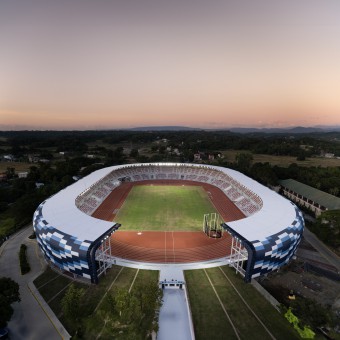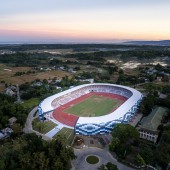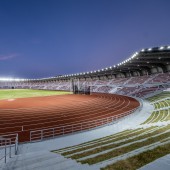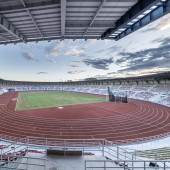Ferdinand E Marcos Stadium Sports Facility by WTA Architecture and Design Studio |
Home > Winners > #154128 |
 |
|
||||
| DESIGN DETAILS | |||||
| DESIGN NAME: Ferdinand E Marcos Stadium PRIMARY FUNCTION: Sports Facility INSPIRATION: Stadiums tend to be underutilized vanity projects that only benefit a few. Why do we need to join appointed tours or buy tickets just to see a public stadium? In building this project we wanted to redefine what a public stadium can be. A piece of social infrastructure that is available to all. The old stadium was an open track that was a daily morning destination for joggers and students. This memory of openness became the kernel for wanting to build a truly public space. The Panathenaic stadium in Athens hosted the first Olympic games. the vast and open feel of that stadium reaches out to the trees beyond creating a quiet and serene quality that has been lost in more and more fantastic stadium forms So as we started sketching the proportions of the stadium We kept thinking about barriers in public spaces. We started imagining how we could build an open stadium. A stadium that would be an integral part of the community A stadium that would extend the adjacent park and connect with the university. the simple sections became the primary expression of our stadium by opening up the southern face of the stadium. We are able to create a stadium park. UNIQUE PROPERTIES / PROJECT DESCRIPTION: The southern end of the stadium incorporates a sloping lawn where people could walk up or have picnics and leads to an amphitheater with a magnificent backdrop. The eastern side that used to be a road now becomes a promenade that connects us with the university where students could freely enter and turns the stadium into part of the campus. The underside of the seats cover warm up tracks that are free for the public's use. This expression of social architecture allows us to create a barrier free stadium that is accessible to everyone. Architecture should not discriminate. Most especially against the poor who need our public space the most. Social spaces should never scrutinize or bar you because you need better clothes or shoes or even identification. You should not need a ticket to enter a space built with the people's money. This is both a stadium and a park. it is a space that does not discriminate. This is a piece of social infrastructure that helps bond the community. It is a stadium for the people. OPERATION / FLOW / INTERACTION: FEM Stadium operates as a multifunctional community hub, offering sports, arts, and daily activities. Its transformation involves integrating cultural elements, enhancing usability. Interaction is seamless, with open access. Better results stem from increased community engagement, tourism, and cultural preservation. Its performance excels due to inclusive design and sustainability. PROJECT DURATION AND LOCATION: The project planning started in 2019 and was built and completed in May 2023. FITS BEST INTO CATEGORY: Architecture, Building and Structure Design |
PRODUCTION / REALIZATION TECHNOLOGY: The Marcos stadium is built by local builders, architects, and engineers. No flights or co2 emissions. Every piece of the structure is produced and assembled locally The Marcos Stadium is sustainable by being local. This is a stadium built for only $20 million. Built without foreign loans or increased taxes. It is the only environmentally and socially sustainable stadium space that truly serves the public. Each seat is locally formed HDPE and every rail locally extruded GI pipe. Every column or beam is built up from locally produced flanges and webs. The roof and catwalk, the steel bays, and concrete decks are robust and laid bare. The entire stadium is clad in affordable locally produced pvc roofing sheets that are lightweight and practical, and impact and uv resistant. They reflect the most common corrugated roofing materials used in local houses.The pattern reduces the scale of the stadium to a more visually digestible form. It is arranged in a local Binakol or whirlwind pattern that creates an optical illusion representing the sea. A traditional pattern passed down from generation to generation, used for local inabel fabrics that are still made by hand and celebrated today. It is a familiar visual identity that ilocanos use to wrap infants at birth, or as veils and shawls for weddings and other formal gatherings. The striking pattern is unmistakable from every angle. It clads this modern geometry in tradition and history. It is a monument that expresses the characteristic frugality and modesty of the Ilocano people and echoes their functional landmarks, from the buttresses of Paoay Church to the windmills of Bangui. This is a character expressed in its boldly exposed structure, an unadorned quality that highlights the vastness, the sense of openness to represent the origins of an agricultural society. SPECIFICATIONS / TECHNICAL PROPERTIES: Total Seating Capacity: 12,000 people Site Area: 43,820 sqm Total Construction Floor Area: 26,613 sqm Pitch & Track Area: 16,475 sqm TAGS: Marcos Stadium, Laoag, Ilocos Norte, Philippines RESEARCH ABSTRACT: Elevate FEM Stadium's functionality and cultural significance in Laoag. WTA employed multidisciplinary methods, including site surveys, interviews, and advanced tools. Engaged local artisans and architects, yielding a culturally rich, revitalized stadium. Insights strengthened community bonds, boosted tourism, and enhanced cultural identity. Redesign serves as a model, harmonizing tradition and modernity, fostering regional growth, and community pride. CHALLENGE: The most challenging aspect of the design was convincing the various stakeholders of the viability of an open stadium and the importance this openness gives to the general public. ADDED DATE: 2023-09-11 03:48:40 TEAM MEMBERS (1) : IMAGE CREDITS: WTA Architecture and Design Studio, 2023. |
||||
| Visit the following page to learn more: https://wtadesignstudio.com/ | |||||
| AWARD DETAILS | |
 |
Ferdinand E Marcos Stadium Sports Facility by Wta Architecture and Design Studio is Winner in Architecture, Building and Structure Design Category, 2023 - 2024.· Read the interview with designer WTA Architecture and Design Studio for design Ferdinand E Marcos Stadium here.· Press Members: Login or Register to request an exclusive interview with WTA Architecture and Design Studio. · Click here to register inorder to view the profile and other works by WTA Architecture and Design Studio. |
| SOCIAL |
| + Add to Likes / Favorites | Send to My Email | Comment | Testimonials | View Press-Release | Press Kit |
Did you like Wta Architecture and Design Studio's Architecture Design?
You will most likely enjoy other award winning architecture design as well.
Click here to view more Award Winning Architecture Design.








